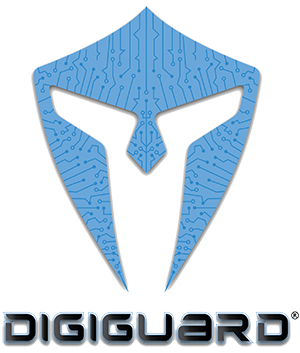You Think You're Safe? Multi-Factor Authentication Can Be Hacked
Summary: This 3-minute article discusses how hackers get around multi-factor authentication and what signs to look out for. Cyber security requires multiple defense layers. Contact DIGIGUARD CYBER SECURITY at 833-33-CYBER (833-332-9237) or visit www.DIGIGUARDsecurity.com to schedule a cyber risk analysis and discuss innovative solutions to ensure your SMB has the best possible small business cyber security.
What Is Multi-Factor Authentication?
Multi-Factor Authentication, or MFA, is a security protocol requiring two or more authentication methods from different types of credentials to verify a user’s identity.
The types of other authenticating credentials are:
- Personal Knowledge – Something that you know, such as another password.
- User Possession – Security tokens and bankcards are examples of user possessions that can be used for confirming their identity. Another method is to send “verification codes” by text messages or emails to their mobile devices.
- Biometric Authentication – Biometric methods include fingerprints, voice prints, facial recognition and retinal scans.
When you enable MFA, if cyber criminals manage to hack your password, multi factor authentication can keep them from breaching all of your accounts. However, cyber thieves always find new ways to get around cyber security protections. Here are a few MFA hacking tricks used by hackers:
- Social Engineering – Social Engineering is employed by hackers after they have compromised a user’s password. Social engineering scams the user into revealing more private information beyond a password to allow them to bypass MFA. The most common attack method used to work around MFA is phishing.
- In phishing attacks, the cyber perpetrator pretends to be a trusted source, usually in an email. Phishing aims to get the user to divulge additional personal data or trick them into clicking a link infected with malware, helping them further compromise the user’s accounts.
- Consent Phishing – Consent Phishing takes advantage of Open Authorization or OAuth, which is an authorization used by many applications to request permission for limited access to a user’s account data. For example, after you make an online restaurant reservation, you might be given the option of adding the reservation details to your calendar (iPhone, Outlook, Google Calendar, etc.). In this instance, you must consent to enough access to allow the reservation app to add the date to your calendar. With Consent Phishing, cybercriminals pretend to be QAuth login pages that, in turn, ask for whatever access they need to launch a cyberattack.
- Brute Force Attacks – Brute Force Attacks are the “old school” of hacking: trying different combinations of passwords until they hit a match. Today, Brute Force Attacks are performed using algorithms that can do the heavy work of running through possible combinations at high speed.
- Authentication Tokens – Online platforms often require the use of special authentication apps that generate temporary identifying codes or tokens. The authentication platforms also offer a manual list of codes to be saved for an emergency. These codes must be stored securely, or they will become a tool for your accounts to be breached by hackers.
- Session Hijacking – Session Hijacking is achieved by cookie stealing. A session cookie containing user credentials is created whenever a user logs into any online platform. That session cookie remains activated until the user logs out. Sessions can be hijacked when a web server doesn’t mark the cookies as secure. If the user unwittingly doesn’t send the session cookie back to the server, hackers can launch a man-in-the-middle attack, stealing the cookie and going around any MFA in place.
The Best Way To Set Up Multifactor Authentication For Your SMB
Fortunately, there are a few basic steps you can take to mitigate hacker MFA workarounds:
- Create Complex Passwords and use longer alphanumeric combinations using upper and lowercase letters and special characters, if permitted.
- Use at least one biometric authentication method, such as retinal scan, facial recognition or fingerprints.
- Resist the Urge to Reuse Passwords, as they can become tools for hackers to access account information.
- Create Server Restrictions limiting the number of attempted and failed logins using MFA
- Conduct Regular Training Sessions with employees for Cyber Security best practices. Everyone must be on the same page when protecting your SMB’s hard-earned business data.
- Only Allow The Use of Trusted Applications. Using random third-party apps without proof of their legitimacy is not a good idea.
- Hire IT experts to perform a cyber vulnerability assessment of your business to determine what additional layers of security might be required to better protect your computer system.
DIGIGUARD’s Innovative Solutions For SMBs
As your SMB grows, expands its network and adds more platforms and devices, such as Bluetooth devices, smart controls, wireless access and remote access, your network vulnerability grows, too. MFA is just one security layer required to fully protect your computer system. DIGIGUARD specializes in proactive cyber security and network security and has a wide array of solutions for small to midsized businesses to defend against cyberattacks. They are cyber security experts who can ensure your confidential personal, business and financial data have the best protection possible. Furthermore, they can help establish cyber security best practices and provide employee training so your staff doesn’t inadvertently expose your company to a cyberattack. That training will work in tandem with the rest of your cyber protections so that everyone knows what they must do to prevent a data breach and precisely what to do in the event of a cyberattack. DIGIGUARD’s services in cyber security are up-to-the-minute and cost-effective. They enable SMB owners to concentrate on operating their businesses without fear of a data breach crippling their operations.
Contact DIGIGUARD CYBER SECURITY at 833-332-CYBER (833-332-9237) www.DIGIGUARDsecurity.com to discuss MFA protections and the best all-encompassing cyber protection for your home or SMB before you face a crippling cyberattack.


